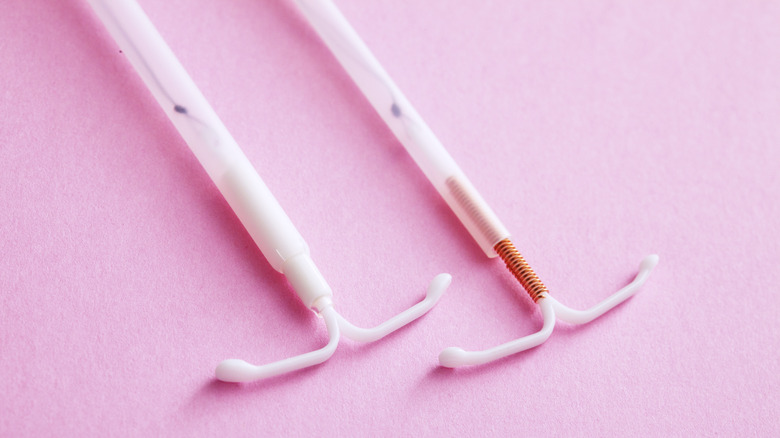The Real Difference Between Hormonal And Non-Hormonal IUDs
Looking for a "set-it-and-forget-it" type of birth control to prevent pregnancy? One that doesn't require you to take an oral pill at a certain time of day, or use physical protection? Well, if you are, you're in luck. Intrauterine devices (IUDs), also known as intrauterine contraception (IUC), fit the bill. Whether hormonal or non-hormonal, IUDs, in general, have been gaining traction as an excellent birth control option for many reasons over their counterparts. According to the Merck Manual, 12% of women in the United States use IUDs.
These tiny T-shaped devices sit inside your uterus to prevent pregnancy. Not sure if you should opt for one that is hormonal or one that is non-hormonal? Interestingly, the differences between the two types come down to more than just hormones. Whichever one you choose, though, you can rest assured of its effectiveness and convenience.
Non-hormonal vs hormonal
Non-hormonal IUDs, are sold under one brand name in the United States: ParaGard. This IUD is partially made of copper, which can prevent sperm from meeting an egg, so it does not contain hormones. Studies show it can be used as an emergency contraception and it's one of the longest-lasting birth controls on the market working up to 10 years or possibly more (via Medical News Today). The downside to this device is it may not be a good fit if you're allergic to copper. You may also experience pain, discomfort, cramping, and it may possibly lengthen your period cycle with heavier flows (via ParaGard). Rarely, perforation can also happen, which is when the device goes through the uterus wall.
If you want a hormonal IUD, you can choose from the brands Mirena, Kyleena, Liletta, and Skyla. Each releases varying amounts of progestin (or levonorgestrel) on a regular basis after they've been inserted into the body. This causes your cervical mucus to thicken, aiding in the prevention of pregnancies. Mirena and Liletta IUDs can last up to six years and contains 52 milligrams of levonorgestrel; Skyla lasts up to three years and contains 13.5 milligrams of levonorgestrel; and Kyleena lasts up to five years and contains 19.5 milligrams of levonorgestrel. Hormonal IUDS can cause changes in your menstrual cycle, such as loss of period (though many see this as a benefit), more susceptibility to pelvic infections, and, rarely, perforation, according to WebMD.
Which is best for you?
Overall, non-hormonal and hormonal IUDs have similar benefits. They're typically affordable, effective at preventing pregnancies (over 99%), and long term, according to Medical News Today. As far as which one to choose, the best IUD for you will really come down to two things: lifestyle and health conditions.
There is no one-size-fits-all solution when it comes to IUDs, so it's best to assess your body and family history, and understand what you're looking for in birth control. If you have heavy periods, you may want to go for a hormonal IUD, since the non-hormonal variety can cause heavier bleeding. Or, if you have a history of pelvic infections, your doctor may advise you to avoid the hormonal IUDs and stick with ParaGard (via Medical News Today).
Choosing an IUD can be a "complex" decision, gynecologist Christopher Destephano told Everyday Health, which is why consulting a doctor is a wise idea. However, as Destephano added, "If you're not comfortable with the counseling you're getting from your doctor, get another opinion."



